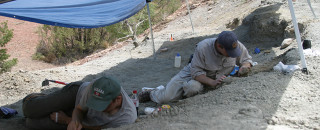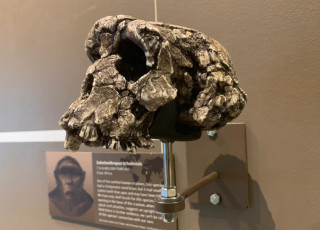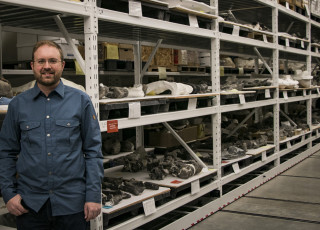Where Are Pterosaurs on the Reptile Family Tree?
By Randall Irmis
Under the intensely hot New Mexican sun, my colleague Sterling Nesbitt slowly and carefully flicked away soft greenish-grey mudstone to reveal the satiny jet-black surface of a four-inch-long exquisitely-preserved 212-million-year-old femur. But what a strange leg bone it was! Neither of us had ever seen one quite like it, with a hook-like head that fit in the hip socket of some unknown Triassic reptile. At that moment, the identity of this diminutive beast frustratingly eluded us.

As part of a team of graduate students embarking on our first field season during the summer of 2006 excavating the Hayden Quarry at Ghost Ranch in northern New Mexico, we had no idea that this first discovery of a single bone would eventually play a crucial role in unraveling an enduring paleontological mystery: where pterosaurs – flying reptiles from the age of dinosaurs – fit on the reptile evolutionary family tree.
Throughout that summer, we found more examples of these peculiar femora, assigning it a dryly categorical nickname of “Reptile A” that reflected the bones’ unknown affinities. But, we began to notice some clear similarities between these leg bones and those of an unusual early dinosaur cousin from Argentina named Lagerpeton chanarensis. Yet the prospect of finding a Lagerpeton-like animal in New Mexico seemed highly unlikely – it was thought to belong to its own ‘one-off’ branch of the evolutionary tree, and was some 25 million years older than the bones from New Mexico.
Thankfully I was lucky enough to receive a grant from the Jurassic Foundation to visit museum collections in Argentina that winter to study specimens of early dinosaurs and dinosaur cousins like Lagerpeton. This opportunity for in-person examination allowed our team to confirm that “Reptile A” was a newly-discovered species of dinosaur cousin very closely related to Lagerpeton. We named this new species Dromomeron romeri in a 2007 publication that made the cover of the journal Science.
Since that fateful day in 2006, we’ve returned to excavate the Hayden Quarry for several weeks every summer, and discovered many more bones of Dromomeron from all different parts of the skeleton.
Yet the story of Dromomeron’s leg bone wasn’t over! Since 2007, other researchers working in both North and South America had also discovered new relatives of Lagerpeton, including specimens preserving parts of the skulls, and this group (including Dromomeron and Lagerpeton) was given a name, Lagerpetidae. As more parts of the skeleton of lagerpetids were discovered, each of these different research groups independently began to notice similarities between these animals and another mysterious extinct reptile group – pterosaurs.
Pterosaurs, sometimes known as pterodactyls, were the first of three groups of vertebrate animals to evolve powered flight, during the Triassic Period, around the time that the first dinosaurs evolved. Yet pterosaurs have puzzled paleontologists for nearly 230 years; their skeleton is so specialized for flying that it retains few clues as to which branch of the reptile family tree the group originated from. This is because we have not discovered pterosaur fossils documenting the evolutionary transitions from a land-bound ancestor to the iconic flying reptiles that capture our imaginations.
As more lagerpetid fossils were discovered, each research group, including ours, began to hypothesize that lagerpetids and pterosaurs shared a close evolutionary relationship. Together, we realized that the strongest way to test this idea would be to to pool our data in a single study. Our combined team of 18 scientists from seven countries and three continents poured over minute details of lagerpetid and pterosaur fossils, in some cases subjecting them to powerful CT scans to see internal structures. We then put these observations into computer-based statistical analyses that test how well these data fit alternative arrangements of the reptile family tree, and specifically the place of pterosaurs and lagerpetids within it.
The journal Nature has just published our conclusions. In the paper, we show that there is strong evidence from dozens of skeletal features that lagerpetids and pterosaurs are each other’s closest relatives, giving us new confidence about where pterosaurs fit in the reptile family tree. What’s more, even though lagerpetids were still exclusively living on terra firma, they share with pterosaur ancestors a number of features in the limbs and inner ear that may have made the transition to flight easier.
And remember that hook-shaped head of the Dromomeron leg bone our team first gazed upon nearly 15 years ago? It turns out that it’s one of the key features linking lagerpetids and pterosaurs! It just goes to show that dusty old bones always have new secrets to reveal!
Randall Irmis is the Chief Curator and Curator of Paleontology at the Natural History Museum of Utah, and an Associate Professor in the Department of Geology & Geophysics, both parts of the University of Utah in Salt Lake City. Our mission is to illuminate the natural world and the place of humans within it. In addition to housing outstanding exhibits for the public, NHMU is a research museum. Learn more.



